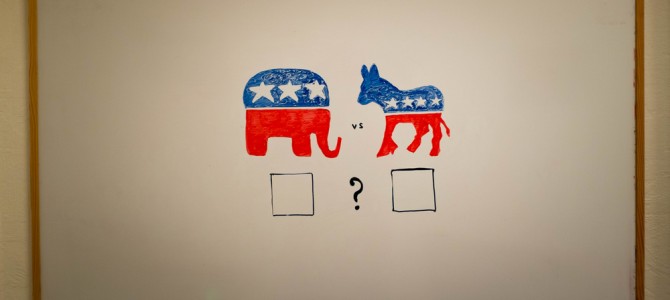
Donald Trump’s populist victory has turned conventional political wisdom on its head. Going into the election, the media and the electorate largely believed Hillary Clinton would crush Trump and become the first woman president. But as the night of November 8 wore on, it became clear that Trump would edge Hillary out. He ended up winning the Electoral College, but lost the popular vote by a record 2.1 percent. In contrast, George W. Bush lost the popular vote by just one half of one percent.
Democrats have won the popular vote in six of the last seven elections: 1992, 1996, 2000, 2008, 2012, and 2016. This is an astonishing feat, which in any other country would have solidified them as the party in power for the foreseeable future. But because we have the Electoral College, the deficiencies in the Democratic coalition are thrown in contrast better than they would be elsewhere.
November 8 revealed that the Democratic base is retreating to urban areas (mostly along the coasts). Their decision to cut bait with working class whites was a mistake. And the Obama coalition disintegrated as soon as Obama was off the ballot. Unless Democrats address these issues, they can expect to see even more losses over the next four years.
Could The Democratic Party Fail?
The following two points are not mutually exclusive: power ebbs and flows between the two major parties, and parties can die. The valley that the Democratic Party currently finds itself in may very well be the former situation. But there is a possibility—however outside the norms of what we’ve come to expect from two-party politics—that the Democratic Party is facing extinction.
The identity crisis facing Democrats is completely different than the one facing the Republican Party. It is even different from the battle for the soul of the Republican Party that came out of the Tea Party movement.
The Tea Party, as Rob Tranciski points out, essentially matched conservative-leaning districts with conservative representatives, especially post-Obamacare when the unpopularity of the law translated into Republican electoral victories. In the Obama era, the fight over the Republican Party was usually between the “establishment”—the career politicians in Washington who served as party thought leaders—and the “base,” or the grassroots voters and activists.
These two factions were often at odds over policies like entitlement spending, defunding Planned Parenthood, and, we now know, free trade deals. But despite these conflicts there was never much dispute over most of the core principals of the party: small government, respect for individual autonomy, Second Amendment rights, Supreme Court appointments, and federalism. Cohesiveness on these issues was showcased at the 2012 and 2016 party conventions, as well in outside forums like CPAC, the March for Life, or NRA-sponsored events.
The issue today in the Republican Party is whether or not it will convert en masse to Trumpism and its hostility to immigration, free trade, NATO, and an introverted foreign policy. But as a whole, there are more holdouts to Trumpism than the media and liberals like to admit.
Why Democrats Suffered This Election
Contrast those issues with the ones facing Democrats: a shrinking base, a shattered coalition, and policies that push people out of the party. One of the main reasons Hillary lost was because of increasing polarization between urban and rural areas. Clinton easily won large metropolises like New York, Chicago, and Los Angeles. She even ran ahead of Obama in those places. But voters further removed from an urban core outvoted the cities and put Trump over the top.
There are number of reasons for this discrepancy. One, Hillary was not Obama, a fact often lost on Democrats during the campaign that is now painfully obvious. The coalition Obama assembled for his two terms was formidable while it lasted. But without him on the ballot, the coalition either stayed home or backed Trump.
A few weeks after the election, The New York Times interviewed a number of less-than-enthused Milwaukee residents about why they voted for Obama in 2008 and 2012, and why they stayed home last year or cast a protest vote. To these voters neither Trump nor Hillary were palatable, and for some the thought of voting for another Democrat felt self-defeating because of the stagnation of their communities during the Obama years.
Others felt like they couldn’t vote for either candidate so they wrote in non-presidential candidates. This drop off in Wisconsin clearly cost Clinton the state: Trump won by just 27,000 votes. This theme came to the fore in the other closely won Trump states like Michigan and Pennsylvania. When it came time to vote for Hillary, the enthusiasm gap was very real.
Progressivism Has Coopted The Democratic Party
Secondly, the policies of the Democratic party increasingly serve as an ideological purity test that lies outside the political mainstream. Internal dissent is often not tolerated. The party position on divisive issues like transgender bathrooms, wedding cake mandates, sanctuary cities, unlimited and unrestricted abortion access, and illegal immigration is mismatched with public opinion. Moderate Blue Dog Democrats, once a large part of the Democratic coalition, are all but extinct. This leaves a party consumed by progressive policies but without a counterbalancing ideology to keep the party apparatus in check.
Finally, the decision to excise the white working class from the Democratic coalition proved to be a fatal mistake. The Clinton team assumed it would win the “Blue Wall” states on the backs of reliable white working class voters who have voted Democratic since 1992 (and in some states, like Wisconsin, since 1984). But her rhetoric on coal, globalism, social issues and Trump’s temperament—combined with the fact that she campaigned around those states—doomed her campaign from the start.
Trump’s message of economic nationalism, protectionism, and “America First” was enough to carry Wisconsin, Michigan, and Pennsylvania and proved the wall wasn’t meant to last.
This Presidential Election Revealed Democrats’ Weaknesses
Thus, Clinton’s defeat can be simplified into three core issues: ideological extremism, a deliberate decision to campaign around a crucial part of her base, and the enthusiasm gap. But in a sense, those causes of defeat are also symptoms of defeat. Clinton campaigned the way she did because she was convinced the Democratic Party had a lock on certain demographics and trends—the so-called “demographic destiny” theory—so the party could move in any direction and only make electoral gains.
The enthusiasm gap was explained away by saying that turnout is always lower in the midterm elections anyway, and Democrats could count on their base to come out for presidential elections. These assumptions were clearly the wrong ones to make. But it led the party to move far enough left that the middle was up for grabs. And Trump was able to capture it.
The debate among Democrats now is how far left to go, or whether to come back to the middle. There isn’t yet much of a consensus (although if Tom Perez’s election to DNC chair means anything, the party is feeling compelled to go wide), but pushing even more left will lead to the death of the Democratic Party as we know it, even if its replacement retains the name.
This Is How The Democratic Party Dies
Assuming the party fails to course correct, which is well within the realm of possibility, it will inevitably become filled with progressive candidates and a base eager to vote them into office. Conservatives sometimes joke that there isn’t much of a difference between a Democrat and a progressive to begin with.
But the key difference is that progressives follow the policies of American liberalism to its logical conclusions. Under progressivism, liberal openness to charter schools becomes a doubled-down commitment to failed public education and its unions. Religious liberty compromises become government-coerced mandates. Popular restrictions on abortion become a hill to die on for unlimited abortion rights. Supreme Court appointments hinge on the mood of the day. Of course, Democrats and liberals already spar with the right over these issues. But as a whole, the party has not completely moved away from its foundations.
This, then, is how the Democratic Party dies. Its death won’t be like the Federalist Party or the Whigs, both of which existed under certain conditions and evaporated when those conditions disappeared with the evolution of the republic. Today’s Democratic Party will die by hollowing itself out to progressive ideology and leaving moderate and historically liberal voters behind.
Democrats are learning the hard way that coalitions are not built on identity, but on ideology. The further left the party moves, the more voters are up for grabs by Republicans. If the party moves far left enough, it might continue to call itself Democratic—but in reality it will be the Progressive Party of America. What 2016 showed is that the Democratic Party as we know it is going extinct.









